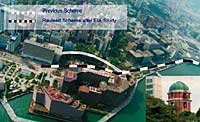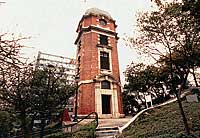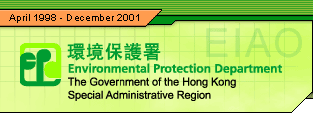|
Content
> Preserving Hong Kong's Natural
Heritage... > Protecting
the Environment for All > Kai
Tak Airport North Apron Decontamination > 1,800
Mega Watt Extension... > West
Rail > International Theme
Park... > Removal of Sediment
in Cheung Sha Wan Fish Culture Zone > Cyberport
Development at Telegraph Bay > Felling
of Five Chimneys at Tsing Yi Power Station > KCR
East Rail Extension > East
Rail Extension
East
Rail Extension - Hung Hom to Tsim Sha Tsui
Project Description
The 1994 Railway
Development Strategy identified the rail extension as a high priority
project to provide a direct rail link between the New Territories
and the heart of the Kowloon Peninsula. It also serves as an interchange
with the Mass Transit Railway (MTR) at Tsim Sha Tsui to relieve
the increasingly overcrowded interchange at Kowloon Tong.
The works include
a 1.5km underground railway, a new East Tsim Sha Tsui (ETST) Station,
a traction substation at Ho Man Tin, and a pedestrian subway system
running under Mody Road, Blenheim Avenue, Signal Hill and Middle
Road linking the new ETST station with the MTR Tsim Sha Tsui Station.
|

Preservation
of Signal Hill, monuments and historical objects.

Conceptual
alignment options for the rail extension.

The
polygonal Eduardian Style Signal Hill Tower built in 1907.
|
Mitigation
Measures and Outcomes
1. The EIA recommended
to change the original rail alignment from Middle Road to Salisbury
Road in order not to cut Signal Hill, and to thus:
- better protect
Signal Hill Tower and other cultural heritage structures and objects;
- keep Signal
Hill Garden intact and open for the public (including 250 regular
Tai Chi practitioners);
- reduce the
volume of construction spoil by 40% (from about 613,000m3
to 371,000m3);
- preserve
a valuable 100 year-old Champion Tree, and over 100 other mature
trees on the southern part of Signal Hill; and
- increase
the total number of trees within the project boundary from 1044
to at least 1500 after the completion of the project.
2. The EIA has
recommended measures to alleviate noise impact during both construction
and operation:
- With quiet
construction plants and appropriate phasing of the construction
programme, the worst residual construction noise impacts at Blenheim
Avenue, Chatham Road, Mody Road and Middle Road will be lowered
from 91-97dB(A) for 11-20 months to 84-86dB(A) for 10-11 months.
- Continuous
construction noise monitoring information will be made available
on KCRC's website within two working days for public inspection.
This is the first project in Hong Kong with such a monitoring
system. The system speeds up the monitoring process and enhances
public participation in noise monitoring.
- A floating
track slab will be installed at the rail tracks to mitigate the
operational ground borne noise impact on the Sheraton Hotel, the
New World Hotel and the Mariner's Club.
3. The EIA has
also recommended the following improvements over the original scheme:
- removal of
land contaminants to protect construction workers and future users
of the Middle Road Children's Playground; and
- elimination
of a visually intrusive conveyor system over Salisbury Road and
a marine platform at the waterfront promenade (which were proposed
for transporting construction spoil).
|


